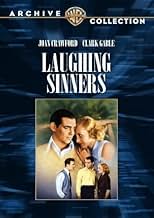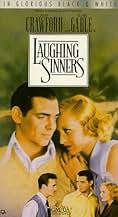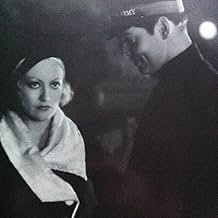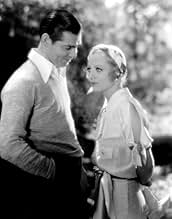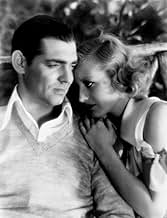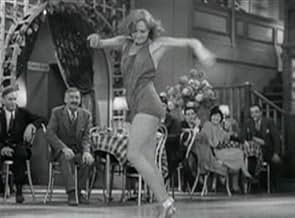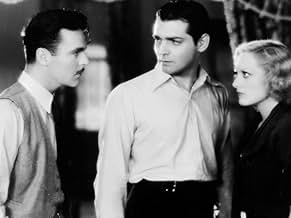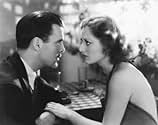Ajouter une intrigue dans votre langueA Salvation Army worker recruits a suicidal cafe dancer.A Salvation Army worker recruits a suicidal cafe dancer.A Salvation Army worker recruits a suicidal cafe dancer.
- Réalisation
- Scénario
- Casting principal
- Récompenses
- 1 victoire au total
Henry Armetta
- Tony
- (non crédité)
Jack Baxley
- Waiter
- (non crédité)
Clara Blandick
- Salvation Army Woman
- (non crédité)
Sherry Hall
- Poker-Playing Salesman
- (non crédité)
Tenen Holtz
- Poker-Playing Salesman
- (non crédité)
Mary Ann Jackson
- Betty
- (non crédité)
Karen Morley
- Estelle Seldon (photo in newspaper)
- (non crédité)
Avis à la une
Interesting early talkie with Joan as a laughing sinner who is then cast aside by her love interest and saved by Clark Gable and the Salvation Army. Having seen Cary Grant previously as a temperance league type (`She Done Him Wrong'), I was able to accept Gable in this same role. Good moral messages as we see how traveling men use `loose' women in small towns and the good that is done by organizations like the Salvation Army.
Aside from that, the best part of the movie is watching Joan dance made up to look like a farmer with a long noses and a long goatee. She sings and dances as well as anyone. Of course switching later into Adrian-designed gowns makes for an interesting contrast. Early in the movie, there is a great facial shot of Joan as she anticipates meeting her boyfriend upstairs in the cabaret. This is a good story and makes for a pleasant hour and a quarter entertainment. Recommended.
Aside from that, the best part of the movie is watching Joan dance made up to look like a farmer with a long noses and a long goatee. She sings and dances as well as anyone. Of course switching later into Adrian-designed gowns makes for an interesting contrast. Early in the movie, there is a great facial shot of Joan as she anticipates meeting her boyfriend upstairs in the cabaret. This is a good story and makes for a pleasant hour and a quarter entertainment. Recommended.
Like a lot of early '30s film, I found this a pretty interesting short (72 minutes) story. This one is about a chorus girl-type who gets jilted, hooks up with a Salvation Army man, then is enticed back to the old sinful ways for a night with the man who jilted her and finally realizes she is better off with the good guy and the good morals.
This is an early look at Joan Crawford, who is blonde here with huge eyes. Clark Gable is sans mustache and really looks young. Neil Hamilton, the third lead, is the same man who went on to play Commissioner Gordon in the Batman TV series three decades later. In here, he's the pagan bad guy.
This film goes a long way in portraying traveling salesmen as morally bankrupt people. Now why would they do that?!!
This is an early look at Joan Crawford, who is blonde here with huge eyes. Clark Gable is sans mustache and really looks young. Neil Hamilton, the third lead, is the same man who went on to play Commissioner Gordon in the Batman TV series three decades later. In here, he's the pagan bad guy.
This film goes a long way in portraying traveling salesmen as morally bankrupt people. Now why would they do that?!!
Joan Crawford is a café dancer whose long term, long distance affair with traveling salesman Neil Hamilton comes crashing to a finish when he dumps her by leaving her a goodbye note written on the back of a menu. Despondent, she sets out to jump into the river, only to be stopped and saved (in more than one sense) by mustache-less Salvation Army officer Clark Gable. Next thing you know, Joan is sporting an Army uniform herself and singing hymns
.but sooner or later, Hamilton is bound to show up again. And what then?
The plot isn't much, but Crawford's performance is excellent as her character veers wildly from joyous flapper to reformed sinner. The scene where she reads Hamilton's note is stunningly sad. Gable never looks quite natural but does seem to contain a reservoir of strength and energy that lurks just beneath the surface of his peaceful character. –At least that's my view from this time and place; hard to imagine what effect his performance would have had on a 1931 audience just becoming familiar with that face, that screen presence.
The highlight of the film is almost certainly Joan's dance in an opening scene—donning a fake nose and beard and a farmer outfit, she humorously bounces around for a couple of minutes before shedding the costume and really cutting loose, to her audience's delight and her own obvious joy. It has to be said that Joan as flapper is quite a bit more exciting than Joan as saved woman.
Hamilton is superb in a thoroughly despicable role. Roscoe Karns and Guy Kibbee are fellow salesman and together they certainly portray the kind of sleazy crew who inspire good people to lock up their daughters.
Overall—no surprises but Crawford is certainly worth watching, especially the opening and closing minutes.
The plot isn't much, but Crawford's performance is excellent as her character veers wildly from joyous flapper to reformed sinner. The scene where she reads Hamilton's note is stunningly sad. Gable never looks quite natural but does seem to contain a reservoir of strength and energy that lurks just beneath the surface of his peaceful character. –At least that's my view from this time and place; hard to imagine what effect his performance would have had on a 1931 audience just becoming familiar with that face, that screen presence.
The highlight of the film is almost certainly Joan's dance in an opening scene—donning a fake nose and beard and a farmer outfit, she humorously bounces around for a couple of minutes before shedding the costume and really cutting loose, to her audience's delight and her own obvious joy. It has to be said that Joan as flapper is quite a bit more exciting than Joan as saved woman.
Hamilton is superb in a thoroughly despicable role. Roscoe Karns and Guy Kibbee are fellow salesman and together they certainly portray the kind of sleazy crew who inspire good people to lock up their daughters.
Overall—no surprises but Crawford is certainly worth watching, especially the opening and closing minutes.
A lot of interesting bits in this. O'Henry bars in 1931?! Reference to the Fresh Air taxi? Acting very good throughout, especially Neil Hamilton who was a real sleazeball. Joan Crawford, who I was never a big fan of, was very pretty, certainly better thas in "This Modern Age" (same year) and almost to her Lucille La Seur standards. The 2nd half was better than the 1st, but they, as was common then, always ended the movie too abruptly. Most revealing was the scene early on in which a bunch of kids were playing in the park, boys & girls. Some were black some were white. Then the religious right and their Code came along after which blacks were only portrayed as servants, buffoons and dullards.
Clark Gable is particularly handsome in his Salvation Army uniform.He is very efficient when it comes to showing seduced girl Crawford the straight and narrow!And he must display lots and lots of patience ,indulgence and compassion for ,even after the marriage of her beau ,a smug buck,she's ready to fall in love again head over heels . Gable and Crawford singing canticles while delivering free meals to the needy.What a nice way to redeem your soul and to find true love!
What's really tragic is that these poor people are still looking for free meals in the soup kitchen ,be it the the Salvation Army or one of the other charitable organizations .In France ,in the organization I'm currently working for("Les Restos Du Coeur" ) ,the number of beneficiaries has increased by 15% in 2010-2011.
What's really tragic is that these poor people are still looking for free meals in the soup kitchen ,be it the the Salvation Army or one of the other charitable organizations .In France ,in the organization I'm currently working for("Les Restos Du Coeur" ) ,the number of beneficiaries has increased by 15% in 2010-2011.
Le saviez-vous
- AnecdotesModern sources state that a preview of the film had such a bad reception that M-G-M production head Irving Thalberg decided to re-shoot part of the picture, dropping Johnny Mack Brown as Carl and re-shoot it with Clark Gable. At that point, Brown's career in mainstream feature films at MGM ended and he transitioned to 'B' westerns.
- GaffesOne year after Howard marries his wealthy boss's daughter he is still a traveling salesman, staying in cheap hotels. The only reason for him to do so is in order for him to meet Ivy again, but it is absurd that his socialite wife would want her husband doing such a job. He could have encountered Ivy in some other way.
- Citations
Man Boarding Train: [annoyed and impatiently waiting to get by a kissing Ivy and Howdy] Well, anytime you get through.
Ivy 'Bunny' Stevens: Mister, we never get through.
- ConnexionsFeatured in Fast Workers (1933)
- Bandes originales(What Can I Do?) I Love That Man
(uncredited)
Music by Martin Broones
Lyrics by Arthur Freed
Sung by Joan Crawford at the cabaret
Meilleurs choix
Connectez-vous pour évaluer et suivre la liste de favoris afin de recevoir des recommandations personnalisées
Détails
- Date de sortie
- Pays d’origine
- Langues
- Aussi connu sous le nom de
- Laughing Sinners
- Lieux de tournage
- Société de production
- Voir plus de crédits d'entreprise sur IMDbPro
Box-office
- Budget
- 338 000 $US (estimé)
- Durée1 heure 12 minutes
- Couleur
Contribuer à cette page
Suggérer une modification ou ajouter du contenu manquant

Lacune principale
By what name was La pécheresse (1931) officially released in India in English?
Répondre
